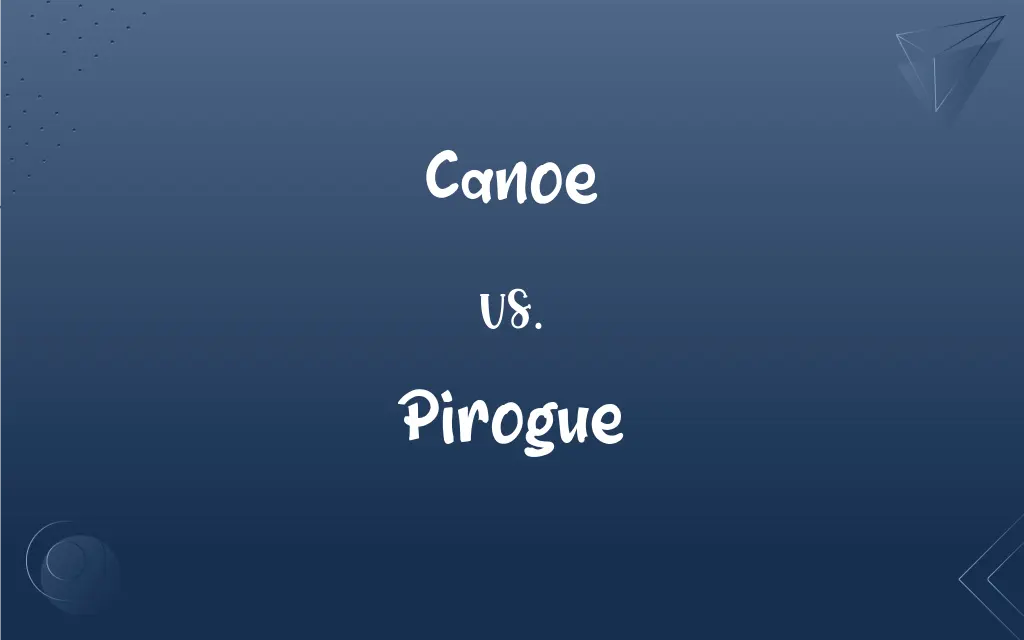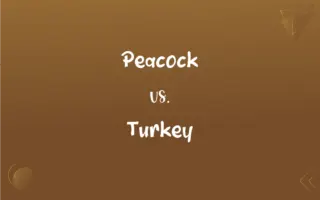Canoe vs. Pirogue: What's the Difference?
By Harlon Moss & Janet White || Updated on May 22, 2024
A canoe is a lightweight, narrow boat open on top, propelled by paddles, while a pirogue is a flat-bottomed boat, often dugout, used in shallow waters and sometimes motorized.

Key Differences
A canoe is a slender, open-topped boat traditionally made from lightweight materials like wood, aluminum, or fiberglass. It is propelled using a single-bladed paddle, with the paddler either kneeling or sitting facing the direction of travel. A pirogue, on the other hand, is a flat-bottomed boat, commonly made from a single tree trunk (dugout) or from planks. Originating from the bayous and swamps of Louisiana, pirogues are designed for shallow waters and can be propelled by paddles, poles, or small motors.
While canoes are typically more open and used for a variety of water conditions, pirogues are specifically designed for shallow, calm waters and often have a more rustic, traditional construction. Canoes have a broader, more global usage, whereas pirogues are more regionally specific, particularly in the Southern United States and parts of the Caribbean.
Canoes generally offer greater stability in open water, while pirogues excel in navigating narrow, shallow waterways. The construction of canoes can range from modern synthetic materials to traditional wood, while pirogues often retain a more traditional, handcrafted appearance.
In terms of cultural significance, canoes have a long history among indigenous peoples in North America and beyond, symbolizing exploration and connection to nature. Pirogues are closely tied to the cultural heritage of the Cajun and Creole communities in Louisiana, representing a practical tool for life in the wetlands.
Comparison Chart
Design
Lightweight, open-topped, narrow
Flat-bottomed, can be dugout or planked
ADVERTISEMENT
Propulsion
Single-bladed paddle
Paddle, pole, or small motor
Water Conditions
Lakes, rivers, calm seas
Shallow, calm waters
Construction Materials
Wood, aluminum, fiberglass
Single tree trunk (dugout), planks
Usage
Recreation, fishing, exploration
Fishing, hunting, transportation
Regional Usage
Global
Southern US, Caribbean
ADVERTISEMENT
Stability
Greater stability in open water
Excellent for shallow, narrow waterways
Cultural Significance
Indigenous peoples, exploration
Cajun and Creole heritage, practical use
Canoe and Pirogue Definitions
Canoe
A traditional boat used by indigenous peoples for transportation and hunting.
The Native American canoe was crafted from birch bark.
Pirogue
A small boat that can be propelled by paddles, poles, or motors.
He used a pole to push the pirogue through the shallow waters.
Canoe
A recreational boat for exploring rivers and lakes.
They rented a canoe for the weekend to explore the river.
Pirogue
A flat-bottomed boat, often dugout, used in shallow waters.
The fisherman navigated the swamp in his pirogue.
Canoe
A narrow, lightweight boat open at the top, propelled by paddles.
We paddled the canoe across the tranquil lake.
Pirogue
A traditional boat made from a single tree trunk or planks.
The pirogue glided smoothly over the bayou's surface.
Canoe
A vessel often used in outdoor activities such as camping and fishing.
The group packed their gear into the canoe before setting off.
Pirogue
A canoe made from a hollowed tree trunk; a piragua.
Canoe
A watercraft designed for paddlers to sit or kneel while paddling.
She knelt in the canoe, paddling steadily downstream.
Pirogue
Any of various boats usually propelled by paddling or poling, especially a light flatbottom boat with pointed ends.
Canoe
A light, slender, usually open boat that has pointed ends and is propelled by paddles.
Pirogue
A canoe of shallow draft, made by hollowing a log.
Canoe
To carry or send by canoe.
Pirogue
A small flat-bottom boat of shallow draft.
Canoe
To travel in or propel a canoe.
Pirogue
(Cajun cooking) A boat-shaped food that is stuffed with seafood.
Canoe
A small long and narrow boat, propelled by one or more people (depending on the size of canoe), using single-bladed paddles. The paddlers face in the direction of travel, in either a seated position, or kneeling on the bottom of the boat. Canoes are open on top, and pointed at both ends.
Pirogue
A dugout canoe; by extension, any small boat.
Canoe
(slang) An oversize, usually older, luxury car.
Pirogue
A canoe made by hollowing out and shaping a large log
Canoe
(gambling) Any of the deflectors positioned around a roulette wheel, shaped like upside-down boats.
Pirogue
A vessel used for fishing, hunting, and transportation in marshy areas.
Hunters often use pirogues to reach remote wetlands.
Canoe
To ride or paddle a canoe.
Pirogue
A type of boat commonly found in Louisiana's bayous and swamps.
The pirogue is an essential part of the local culture and lifestyle.
Canoe
A boat used by rude nations, formed of trunk of a tree, excavated, by cutting of burning, into a suitable shape. It is propelled by a paddle or paddles, or sometimes by sail, and has no rudder.
Others devised the boat of one tree, called the canoe.
Canoe
A boat made of bark or skins, used by savages.
A birch canoe, with paddles, rising, falling, on the water.
Canoe
A light pleasure boat, especially designed for use by one who goes alone upon long excursions, including portage. It it propelled by a paddle, or by a small sail attached to a temporary mast.
Canoe
To manage a canoe, or voyage in a canoe.
Canoe
Small and light boat; pointed at both ends; propelled with a paddle
Canoe
Travel by canoe;
Canoe along the canal
FAQs
Where are canoes commonly used?
Canoes are used globally in lakes, rivers, and calm seas for recreation, fishing, and exploration.
How is a pirogue propelled?
Pirogues can be propelled by paddles, poles, or small motors.
What is a pirogue?
A pirogue is a flat-bottomed boat, often made from a single tree trunk or planks, used in shallow waters.
What is a canoe?
A canoe is a lightweight, narrow boat open at the top, propelled by single-bladed paddles.
Where are pirogues commonly used?
Pirogues are commonly used in the Southern US, particularly in Louisiana, and in parts of the Caribbean.
What materials are canoes made from?
Canoes can be made from wood, aluminum, or fiberglass.
Do pirogues offer good stability?
Yes, pirogues are very stable in shallow and narrow waterways.
How is a canoe propelled?
Canoes are propelled by paddlers using single-bladed paddles.
Do canoes offer good stability?
Yes, canoes generally offer good stability in open water.
What kind of water are canoes suitable for?
Canoes are suitable for lakes, rivers, and calm seas.
What kind of water are pirogues suitable for?
Pirogues are suitable for shallow, calm waters like bayous and swamps.
What activities are pirogues used for?
Pirogues are used for fishing, hunting, and transportation in marshy areas.
Can canoes be used for long-distance travel?
Yes, canoes can be used for long-distance travel, especially in rivers and lakes.
What materials are pirogues made from?
Pirogues are traditionally made from a single tree trunk (dugout) or planks.
Can pirogues be used for long-distance travel?
Pirogues are generally used for shorter distances due to their design for shallow waters.
Are canoes used for cultural or historical purposes?
Yes, canoes have significant cultural and historical importance, especially among indigenous peoples.
Are pirogues used for cultural or historical purposes?
Yes, pirogues are part of the cultural heritage of Cajun and Creole communities.
What activities are canoes used for?
Canoes are used for recreation, fishing, camping, and exploration.
Are canoes used in competitive sports?
Yes, canoes are used in competitive sports like canoe racing and slalom.
Are pirogues used in competitive sports?
No, pirogues are primarily used for practical purposes rather than sports.
About Author
Written by
Harlon MossHarlon is a seasoned quality moderator and accomplished content writer for Difference Wiki. An alumnus of the prestigious University of California, he earned his degree in Computer Science. Leveraging his academic background, Harlon brings a meticulous and informed perspective to his work, ensuring content accuracy and excellence.
Co-written by
Janet WhiteJanet White has been an esteemed writer and blogger for Difference Wiki. Holding a Master's degree in Science and Medical Journalism from the prestigious Boston University, she has consistently demonstrated her expertise and passion for her field. When she's not immersed in her work, Janet relishes her time exercising, delving into a good book, and cherishing moments with friends and family.
































































